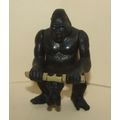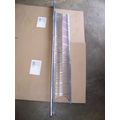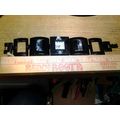Pinturicchio (Bernadino di Betto) - Portrait of a Young Man - Medici postcard
- Condition : Used
- Dispatch : 2 Days
- Brand : None
- ID# : 79266951
- Quantity : 1 item
- Views : 2357
- Location : United Kingdom

- Seller : justthebook (+1703)
- Barcode : None
- Start : Sun 21 Oct 2012 23:31:00 (BST)
- Close : Run Until Sold
- Remain : Run Until Sold
More Listings from This Seller view all
Seller's Description
- Art Postcard
- Work of art title: Portrait of a Young Man
- Artist (if known): Pintoricchio (or Pinturicchio according to Wikipedia) (Bernadino di Betti)
- Media or other details: painting
- Publisher / Gallery: The Medici Society, London, c.1950s
- Postally used: yes:
- Stamp & postmark details (if relevant): posted Oxford to Birmingham 1955 with 2d brown Wilding definitive stamp
- Size: modern
- Notes & condition details: very slight postmark lines on front (barely visible in scan)
NOTES:
Size: 'Modern' is usually around 6in x 4in / 'Old Standard' is usually around 5 1/2in x 3 1/2in. Larger sizes mentioned, but if you need to know the exact size please ask.
All postcards are not totally new and are pre-owned. It's inevitable that older cards may show signs of ageing and use, particularly sent through the post. Any faults other than normal ageing are noted.
Stock No.: A426
------------------------------------------------
Postage & Packing:
UK (incl. IOM, CI & BFPO): 99p
Europe: GBP 1.60
Rest of world (inc. USA etc): GBP 2.75
No additional charges for more than one postcard. You can buy as many postcards from me as you like and you will just pay the fee above once. (If buying postcards with other things such as books, please contact or wait for invoice before paying).
Payment Methods:
UK - PayPal, Cheque (from UK bank) or postal order
Outside UK: PayPal only please (unless otherwise indicated). NO non-UK currency checks or money orders (sorry).
NOTE: All postcards are sent in brand new stiffened envelopes which I have bought for the task. These are specially made to protect postcards and you may be able to re-use them. In addition there are other costs to sending so the above charge is not just for the stamp!
----------------------------------------------
Text from the free encyclopedia WIKIPEDIA may appear below to give a little background information:
*************
Bernardino di Betto, called Pintoricchio or Pinturicchio (Italian: [pintu'rikkjo]; 1454�1513) was an Italian painter of the Renaissance. He acquired his nickname, Pintoricchio (""little painter""), because of his small stature, and he used it to sign some of his works.
He was born in Perugia, the son of Benedetto or Betto di Blagio. He may have trained under lesser known Perugian painters such as Bonfigli and Fiorenzo di Lorenzo. According to Vasari, Pinturicchio was a paid assistant of Perugino.
The works of the Perugian Renaissance school are very similar; and paintings by Perugino, Pinturicchio, Lo Spagna and a young Raphael may often be mistaken one for the other. In the execution of large frescoes, pupils and assistants had a large share in the work, either in enlarging the master's sketch to the full-sized cartoon, in transferring the cartoon to the wall, or in painting backgrounds or accessories.
After assisting Perugino in his frescoes in the Sistine Chapel, Pinturicchio was employed by various members of the Della Rovere family and others to decorate palaces (the Semi-Gods Ceiling of Palazzo dei Penitenzieri) and a series of chapels in the church of Santa Maria del Popolo in Rome, where he appears to have worked from 1484, or earlier, to 1492. The earliest of these is an altarpiece of the Adoration of the Shepherds, in the first chapel (from the west) on the south, built by Cardinal Domenico della Rovere; a portrait of the cardinal is introduced as the foremost of the kneeling shepherds. In the lunettes under the vault Pinturicchio painted small scenes from the life of St Jerome.
The frescoes which he painted in the next chapel, built by Cardinal Innocenzo Cybo, were destroyed in 1700, when the chapel was rebuilt by Cardinal Alderano Cybo. The third chapel on the south is that of Giovanni della Rovere, duke of Sora, nephew of Sixtus IV, and brother of Giuliano, who was afterwards Pope Julius II. This contains a fine altarpiece of the Madonna enthroned between Four Saints, and on the east side a very nobly composed fresco of the Assumption of the Virgin. The vault and its lunettes are richly decorated with small pictures of the Life of the Virgin, surrounded by graceful arabesques; and the dado is covered with monochrome paintings of scenes from the lives of saints, medallions with prophets, and very graceful and powerfully drawn female figures in full length in which the influence of Signorelli may be traced.
In the fourth chapel, Pinturicchio painted the Four Latin Doctors in the lunettes of the vault. Most of these frescoes are considerably injured by moisture and have suffered little from restoration. The last paintings completed by Pinturicchio in this church are found on the vault behind the choir, where he painted decorative frescoes, with main lines arranged to suit their surroundings in a skillful way. In the centre is an octagonal panel of the Coronation of the Virgin, and surrounding it, are medallions of the Four Evangelists. The spaces between them are filled by reclining figures of the Four Sibyls. On each pendentive is a figure of one of the Four Doctors enthroned under a niched canopy. The bands which separate these pictures have elaborate arabesques on a gold ground, and the whole is painted with broad and effective touches, very telling when seen (as is necessarily the case) from a considerable distance below. No finer specimen of the decoration of a simple quadripartite vault can be seen anywhere.
In 1492 Pinturicchio was summoned to Orvieto, where he painted two Prophets and two of the Doctors in the Cathedral. He then returned to Rome, and was employed by Pope Alexander VI (Borgia) to decorate a recently completed suite of six rooms, the Appartamenti Borgia in the Vatican. These rooms now form part of the Vatican library, and five still retain a series of Pinturicchio frescoes. The Umbrian painter worked in these rooms till around 1494, assisted by his pupils, and not without interruption. His other chief frescoes in Rome, still existing in a very genuine state, are those in the Bufalini Chapel in the southwest sector of Santa Maria in Ara Coeli, probably executed around 1484-1486. On the altar wall is a grand painting of St Bernardino of Siena between two other saints, crowned by angels; in the upper part is a figure of Christ in a mandorla, surrounded by angel musicians; on the left wall is a large fresco of the miracles performed by the corpse of St Bernardino, which includes portraits of members of the sponsoring Bufalini family.
One group of three females, the central figure with a child at her breast, recalls the grace of Raphael's second manner. The composition of the main group round the saint's corpse appears to have been suggested by Giotto's painting of St. Francis on his bier found in Santa Croce at Florence. On the vault are four noble figures of the Evangelists, usually attributed to Luca Signorelli, but more likely, as with the rest of the frescoes in this chapel, by the hand of Pinturicchio. On the vault of the sacristy of Santa Cecilia in Trastevere, Pinturicchio painted the Almighty surrounded by the Evangelists. During a visit to Orvieto in 1496, Pinturicchio painted two more figures of the Latin Doctors in the choir of the Duomo. Now, like the rest of his work at Orvieto, these figures are almost destroyed. For these he received fifty gold ducats. In Umbria, his masterpiece is the Baglioni Chapel in the church of S. Maria Maggiore in Spello.
Among his panel pictures the following are the most important. An altarpiece for S. Maria de' Fossi at Perugia, painted in 1496-1498, now moved to the city's picture gallery, is a Madonna enthroned among Saints, very minutely painted; the wings of the retable have standing figures of St Augustine and St Jerome; and the predella has paintings in miniature of the Annunciation and the Evangelists. Another fine altarpiece, similar in delicacy of detail, and probably painted about the same time, is that in the cathedral of San Severino � the Madonna enthroned looks down towards the kneeling donor. The angels at the sides in beauty of face and expression recall the manner of Lorenzo di Credi or Da Vinci.
The Vatican picture gallery has the largest of Pinturicchio's panels � the Coronation of the Virgin, with the apostles and other saints below. Several well-executed portraits occur among the kneeling saints. The Virgin, who kneels at Christ's feet to receive her crown, is a figure of great tenderness and beauty, and the lower group is composed with great skill and grace in arrangement.
In 1504 he designed a mosaic floor panel for the Cathedral of Siena: the Story of Fortuna, or the Hill of Virtue. This was executed by Paolo Mannucci in 1506. On top of the panel, Knowledge hands the palm of victory to Socrates.
The Ashmolean Museum (University of Oxford), Biblioteca Ambrosiana (Milan), the Cleveland Museum of Art, the Courtauld Institute of Art (London), the Denver Art Museum, the Fitzwilliam Museum (University of Cambridge), the Honolulu Museum of Art, the Louvre, the Museum of Fine Arts, Boston, the National Gallery, London, Palazzo Ruspoli (Rome), the Philadelphia Museum of Art, the Pinacoteca Ambrosiana (Milan), Princeton University Art Museum, Walters Art Museum in Baltimore and the Vatican Museums are among the public collections holding works by Pinturicchio. There are also paintings by this painter in the Museum of Fine Arts (Budapest, Hungary) and the Ferenc Mora Museum (Szeged, Hungary).
type=printed postcards
theme=artists signed
sub-theme=art
number of items=single
period=1945 - present
postage condition=posted
Listing Information
| Listing Type | Gallery Listing |
| Listing ID# | 79266951 |
| Start Time | Sun 21 Oct 2012 23:31:00 (BST) |
| Close Time | Run Until Sold |
| Starting Bid | Fixed Price (no bidding) |
| Item Condition | Used |
| Bids | 0 |
| Views | 2357 |
| Dispatch Time | 2 Days |
| Quantity | 1 |
| Location | United Kingdom |
| Auto Extend | No |




 for 1 item(s)
for 1 item(s)














